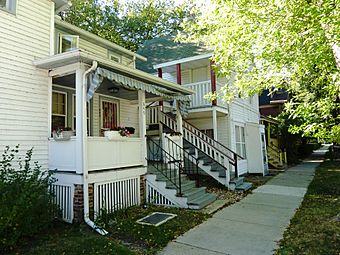East Dayton Street Historic District facts for kids
Quick facts for kids |
|
|
East Dayton Street Historic District
|
|

A portion of the district, September 2012
|
|
| Location | 649-53 East Dayton Street and 114 North Blount Street Madison, Wisconsin United States |
|---|---|
| Area | 0.4 acres (0.16 ha) |
| NRHP reference No. | 88000217 |
| Added to NRHP | December 27, 1988 |
The East Dayton Street Historic District is a special area in Madison, Wisconsin. It is listed on the National Register of Historic Places. This means it is an important part of American history. This district has three old buildings. They are the last parts of Madison's first Black neighborhood. This neighborhood grew around East Dayton Street in the early 1900s.
Contents
What is the East Dayton Street Historic District?
This small historic area is about half an acre in size. It includes three important buildings. All three buildings were moved to their current spots a long time ago. This happened in the early 1900s.
The Miller House
The Miller House is at 647 East Dayton Street. It was moved in 1908. This is a two-story house made of wood. It was once the home of William and Anna Mae Miller and their family. This house is also listed on the National Register of Historic Places by itself.
Other Buildings in the District
The building at 649-653 East Dayton Street is actually two buildings joined together. One part was moved in 1901, and the other in 1912. One section was a store, and the other was a house. The third building is a one-and-a-half story house. It is located at 114 North Blount Street. This house was moved to its spot in 1923.
History of the East Dayton Street Neighborhood
East Dayton Street became the first Black neighborhood in Madison. This happened in the early 1900s. The first Black family to move here was John Turner's family. They settled on Blount Street in 1898. In 1900, there were 19 Black families in all of Madison.
Early Leaders and Community Life
The Turner family started the Douglas Beneficial Society. This group helped Black residents in the city. In 1901, they opened a meeting hall at 649 Dayton Street. William Miller was another important leader. He worked for Wisconsin governor Robert M. La Follette.
Turner and Miller also helped start the city's African Methodist Episcopal Church in 1902. The original church building is no longer there. But the church was very important to the neighborhood back then. The house at 653 East Dayton Street was home to C. H. Thomas. He was the church's pastor. Another group, a Prince Hall Masonic lodge, started in 1906.
Growth of the Neighborhood
William Miller married Anna Mae Stewart in 1904. They owned three houses in the neighborhood. The house at 647 East Dayton is the only one left. It was a boarding house before the Millers lived there in 1919. By 1910, about half of all Black families in Madison lived in the East Dayton area. This included the family of Benjamin Butts. He was a veteran of the American Civil War.
Changes Over Time
In 1917, John and Amanda Hill changed the Douglas Beneficial Society hall into a grocery store. John Hill was also a leader at the AME Church. The house at 114 North Blount was moved in 1923 for Amanda Hill's mother.
After 1923, the neighborhood stopped growing much. New Black residents in Madison started moving to the Greenbush neighborhood. This was on Madison's west side. In the 1960s, many residents moved to other parts of the city. Because of this, many of the original buildings were torn down.
The East Dayton Street Historic District was officially listed as a historic place. It was added to the National Register of Historic Places on March 22, 1988. It was added to the State Register of Historic Places the next year.
Images for kids



